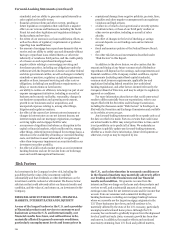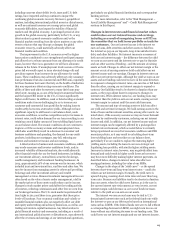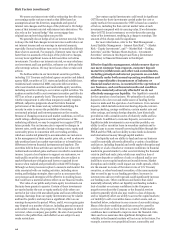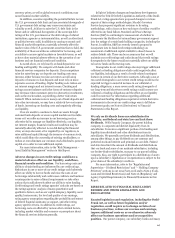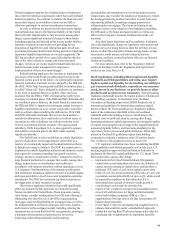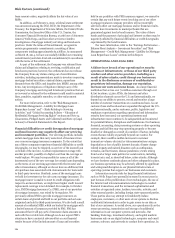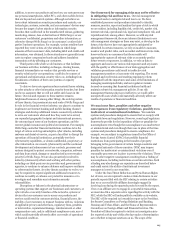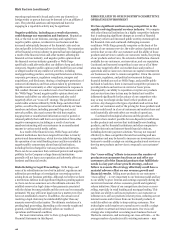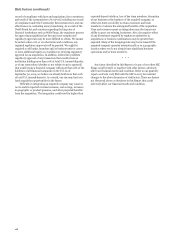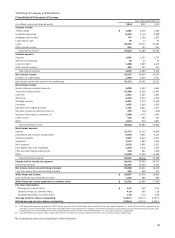Wells Fargo 2014 Annual Report Download - page 124
Download and view the complete annual report
Please find page 124 of the 2014 Wells Fargo annual report below. You can navigate through the pages in the report by either clicking on the pages listed below, or by using the keyword search tool below to find specific information within the annual report.Risk Factors (continued)
Our mortgage banking revenue can be volatile from
quarter to quarter, including as a result of changes in
interest rates and the value of our MSRs and MHFS,
and we rely on the GSEs to purchase our conforming
loans to reduce our credit risk and provide liquidity to
fund new mortgage loans. We were the largest mortgage
originator and residential mortgage servicer in the U.S. as of
December 31, 2014, and we earn revenue from fees we receive
for originating mortgage loans and for servicing mortgage loans.
As a result of our mortgage servicing business, we have a sizeable
portfolio of MSRs. An MSR is the right to service a mortgage
loan – collect principal, interest and escrow amounts – for a fee.
We acquire MSRs when we keep the servicing rights after we sell
or securitize the loans we have originated or when we purchase
the servicing rights to mortgage loans originated by other
lenders. We initially measure and carry all our residential MSRs
using the fair value measurement method. Fair value is the
present value of estimated future net servicing income,
calculated based on a number of variables, including
assumptions about the likelihood of prepayment by borrowers.
Changes in interest rates can affect prepayment assumptions
and thus fair value. When interest rates fall, borrowers are
usually more likely to prepay their mortgage loans by refinancing
them at a lower rate. As the likelihood of prepayment increases,
the fair value of our MSRs can decrease. Each quarter we
evaluate the fair value of our MSRs, and any decrease in fair
value reduces earnings in the period in which the decrease
occurs. We also measure at fair value MHFS for which an active
secondary market and readily available market prices exist. In
addition, we measure at fair value certain other interests we hold
related to residential loan sales and securitizations. Similar to
other interest-bearing securities, the value of these MHFS and
other interests may be negatively affected by changes in interest
rates. For example, if market interest rates increase relative to
the yield on these MHFS and other interests, their fair value may
fall. When rates rise, the demand for mortgage loans usually
tends to fall, reducing the revenue we receive from loan
originations. Under the same conditions, revenue from our
MSRs can increase through increases in fair value. When rates
fall, mortgage originations usually tend to increase and the value
of our MSRs usually tends to decline, also with some offsetting
revenue effect. Even though they can act as a “natural hedge,”
the hedge is not perfect, either in amount or timing. For
example, the negative effect on revenue from a decrease in the
fair value of residential MSRs is generally immediate, but any
offsetting revenue benefit from more originations and the MSRs
relating to the new loans would generally accrue over time. It is
also possible that, because of economic conditions and/or a weak
or deteriorating housing market, even if interest rates were to
fall or remain low, mortgage originations may also fall or any
increase in mortgage originations may not be enough to offset
the decrease in the MSRs value caused by the lower rates.
We typically use derivatives and other instruments to hedge
our mortgage banking interest rate risk. We may not hedge all of
our risk, and we may not be successful in hedging any of the risk.
Hedging is a complex process, requiring sophisticated models
and constant monitoring, and is not a perfect science. We may
use hedging instruments tied to U.S. Treasury rates, LIBOR or
Eurodollars that may not perfectly correlate with the value or
income being hedged. We could incur significant losses from our
hedging activities. There may be periods where we elect not to
use derivatives and other instruments to hedge mortgage
banking interest rate risk.
We rely on GSEs to purchase mortgage loans that meet their
conforming loan requirements and on the Federal Housing
Authority (FHA) to insure loans that meet their policy
requirements. These loans are then securitized into either GSE
or GNMA securities that are sold to investors. In order to meet
customer needs, we also originate loans that do not conform to
either GSE or FHA standards, which are referred to as
“nonconforming” loans. We generally retain these
nonconforming loans on our balance sheet. When we retain a
loan on our balance sheet not only do we forgo fee revenue and
keep the credit risk of the loan but we also do not receive any
sale proceeds that could be used to generate new loans. If we
were unable or unwilling to continue retaining nonconforming
loans on our balance sheet, whether due to regulatory, business
or other reasons, our ability to originate new mortgage loans
may be reduced, thereby reducing the fees we earn from
originating and servicing loans. Similarly, if the GSEs or the FHA
were to limit or reduce their purchases of loans, our ability to
fund, and thus originate new mortgage loans, could also be
reduced. We cannot assure that the GSEs or the FHA will not
materially limit their purchases of conforming loans or change
their criteria for what constitutes a conforming loan (e.g.,
maximum loan amount or borrower eligibility). Each of the
GSEs is currently in conservatorship, with its primary regulator,
the Federal Housing Finance Agency acting as conservator. We
cannot predict if, when or how the conservatorship will end, or
any associated changes to the GSEs business structure and
operations that could result. As noted above, there are various
proposals to reform the housing finance market in the U.S.,
including the role of the GSEs in the housing finance market.
The impact of any such regulatory reform regarding the housing
finance market and the GSEs, including whether the GSEs will
continue to exist in their current form, as well as any effect on
the Company’s business and financial results, are uncertain.
For more information, refer to the “Risk Management –
Asset/Liability Management – Mortgage Banking Interest Rate
and Market Risk” and “Critical Accounting Policies” sections in
this Report.
We may be required to repurchase mortgage loans or
reimburse investors and others as a result of breaches
in contractual representations and warranties, and we
may incur other losses as a result of real or alleged
violations of statutes or regulations applicable to the
origination of our residential mortgage loans. The
origination of residential mortgage loans is governed by a variety
of federal and state laws and regulations, including the Truth in
Lending Act of 1968 and various anti-fraud and consumer
protection statutes, which are complex and frequently changing.
We often sell residential mortgage loans that we originate to
various parties, including GSEs, SPEs that issue private label
MBS, and other financial institutions that purchase mortgage
loans for investment or private label securitization. We may also
pool FHA-insured and VA-guaranteed mortgage loans which
back securities guaranteed by GNMA. The agreements under
which we sell mortgage loans and the insurance or guaranty
agreements with the FHA and VA contain various
representations and warranties regarding the origination and
characteristics of the mortgage loans, including ownership of the
loan, compliance with loan criteria set forth in the applicable
agreement, validity of the lien securing the loan, absence of
delinquent taxes or liens against the property securing the loan,
and compliance with applicable origination laws. We may be
required to repurchase mortgage loans, indemnify the
securitization trust, investor or insurer, or reimburse the
122




